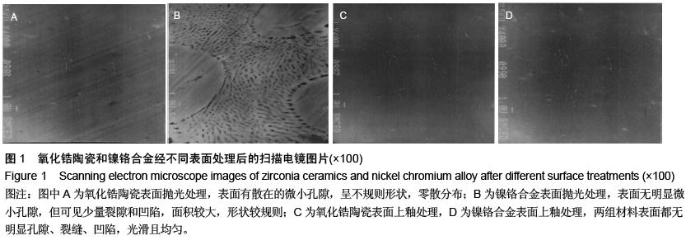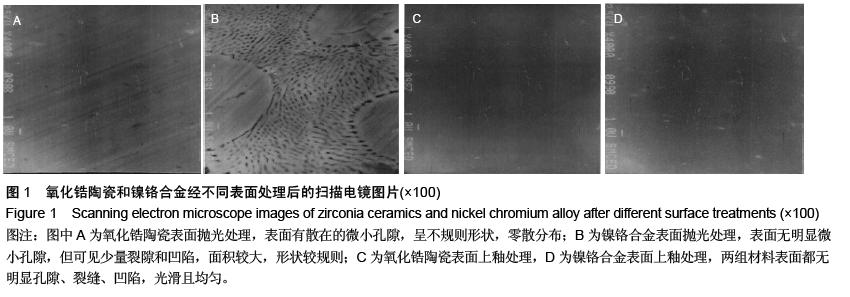| [1] 丁玉宝,杨建军,杨凤丽,等.氧化锆陶瓷材料的生物相容性[J].中国组织工程研究与临床康复, 2011,15 (12): 2153-2156.
[2] 丁宁,张祖太,何敏,等.几种常用口腔材料细菌粘附性能比较[J].北京口腔医学,2014,22(5):258-260.
[3] Aykent F,Yondem I,Ozyesil AG,et al.Effect of different finishing techniques for restorative materials on surface roughness and bacterialadhesion.J Prosthet Dent. 2010; 103(4):221-227.
[4] Al-Ahmad A,Wiedmann-Al-Ahmad M,Fackler A,et al.In vivo study of the initial bacterial adhesion on different implant materials.Arch Oral Biol. 2013;58((9):
1139-1147.
[5] 陈吉华,肖玉鸿,李芳,等.季铵盐抗菌单体改性牙本质粘接剂的抗菌性能研究[J].北京口腔医学, 2010,18(4): 181-184.
[6] Necula BS,Apachitei I,Tichelaar FD,et al.An electron microscopical study on the growth of TiO2- Ag antibacterial coatings on Ti6Al7Nb biomedical alloy. Acta Biomater.2011;7(6):2751-2757.
[7] 王希晨,吴建勇.热激活镍钛弓丝的性能及研究进展[J].南昌大学学报:医学版,2011, 51(5): 94-96.
[8] Nguyen-Phan TD,Pham VH,Cuong TV,et al. Fabrication of TiO2 nanostructured films by spray deposition with high photocatalytic activity of methylene blue.Mater Lett.2010; 64(12): 1387-1390.
[9] Sun DQ,Li HM.Anew method of TiNi shape memory alloy and austenitic stainless steel different Kind of material connection.CN Patent.2011;CNIO 215201708.
[10] Zheng YF,Zhang BB,Wang BL,et al.Introduction of antibacterial function into biomedical TiNi shape memory alloy by the addition of element Ag.Acta Biomaterialia. 2011;7(6):2758-2767.
[11] 徐晋勇,高原,高成,等.抗菌金属材料的研究进展[J].腐蚀科学与防护技术,2010,22(6):563-566.
[12] Min SH,Yang JH,Kim JY,et al.Development of white antibacterial pigment based on silver chloride nanoparticles and mesoporous silica and its polymer composite.Micropor Mesopor Mater. 2010;128(1-3): 19-25.
[13] 张晟,麦理想,柳大烈,等.纳米 Ag/TiO2涂层托槽对口腔常见细菌的抗菌性能研究[J].实用医学杂志, 2012,28(9): 1408-1410.
[14] Li H,Sun D,Han Y,et al.Microstructures and mechanical properties of laser-welded TiNi shape memory alloy and stainless steel wires.China Welding. 2010;19(3): 1-5.
[15] Zhang C,Sun X,Hou X,et al.The corrosion resistance of composite arch wire laser-welded by NiTi shape memory alloy and stainless steel wires with Cu interlayer in artificial saliva with protein.Int J Med Sci. 2013;10(8):1068-1072.
[16] Zhang C,Sun X,Zhao S,et al.Susceptibility to Corrosion and In Vitro Biocompatibility of a Laser-Welded Composite Orthodontic Arch Wire.Ann Biomed Eng. 2014;42(1):222-230.
[17] Zhang C,Sun X,Sun X,et al.Corrosion of laser-welded NiTi shape memory alloy and stainlesssteel composite wires with a copper interlayer u pon exposure to fluorideand mechanical stress.Corros Sci. 2014; 82(5): 404-409.
[18] Yano K,Fukushima Y.Particle size control of mono-dispersed super- microporous silica spheres.J Mater Chem.2003;13(10):2577-2581.
[19] 张玉梅,马千里,梅盛林,等.载银二氧化钛纳米管阵列表面涂层的表面观察分析和细胞毒性评估[J].牙体牙髓牙周病学杂志,2010,20(9):492-497.
[20] Ahamed M,Alsalhi MS,Siddiqui MK.Silver nanoparticle applications and human health.Clin Chim Acta.2010;411(23-24):1841-1848.
[21] 王立坤,柯伟.贵金属烤瓷冠与非贵金属烤瓷冠对牙龈组织影响的临床比较[J].长江大学学报(自然科学版), 2010, 7(2):42-43.
[22] 刘涛,吕一品,姚辰琛,等.口腔微生态的研究进展[J].生命科学研究,2012,16(5):466-470.
[23] 杨隆强,周乔,刘敏川.变异链球菌黏附机制的研究进展[J].国际口腔医学杂志,2011,38(2):229-234.
[24] Rammohan SN,Juvvadi SR,Gandikota CS,et al.Adherence of Streptococcus mutans and Candida albicans to different bracket materials.J Pharm Bioallied Sci.2012;2(4):212-216.
[25] Yamane K,Ayukawa Y,Takeshita T,et al.Bacterial adhesion affinities of various implant abutment materials.Clin Oral Implants Res.2012;8(27):1-6.
[26] 张燕丽,李英.贵金属冠修复对微生物早期黏附的影响[J].中国中医药7指南,2011,9(1):64-65.
[27] 卞洁,张怀勤,马骏驰.载银抗菌剂对造牙树脂材料颜色的影响[J].临床口腔医学杂志, 2010,26(6):330-331.
[28] Peng JJ,Botelho MG,Matinlinna JP.Silver compounds used in dentistry for caries management: A review.J Dent.2012;40(7):531-541.
[29] Sodagar A, Kassaee MZ,Akhavan A,et al. Effect of silver nano particles on flexural strength of acrylic resins.J Prosthodont Res.2012;56(2):120-124. |

